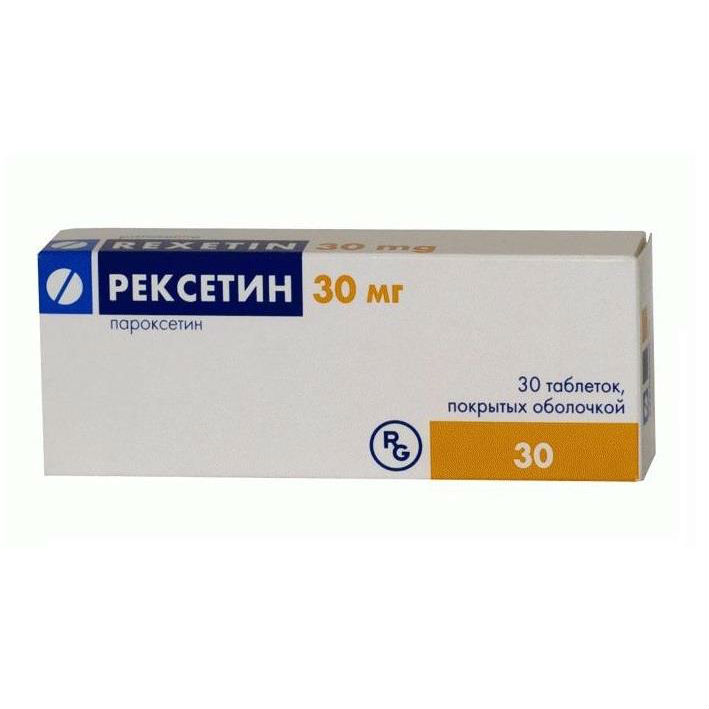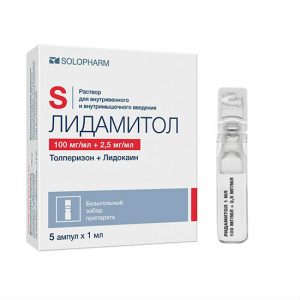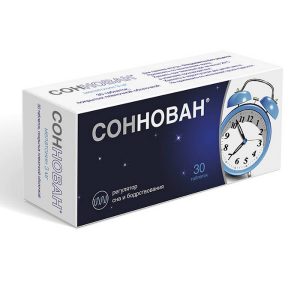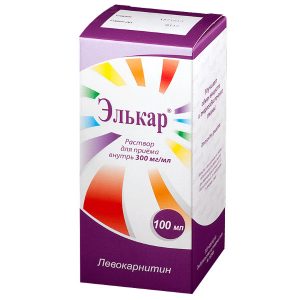Description
Latin name
REXETIN
Packing
In 1 blister pack of 10 tablets. In a cardboard bundle 3 blisters.
Pharmacological action
Rexetin is an antidepressant. Inhibits reverse neuronal uptake of serotonin in the central nervous system.
Little effect on the neuronal uptake of norepinephrine and dopamine.
It also has anxiolytic and psychostimulating effects.
Indications
– Depression of various etiologies, incl. conditions accompanied by anxiety.
– Obsessive-compulsive disorder (obstruction syndrome).
– Panic disorders, including with fearia in the crowd (agoraphobia).
– Sociophobia.
– Generalized Anxiety Disorder (GAD).
– Post-Traumatic Stress Disorders.
Also used as part of anti-relapse treatment.
Contraindications
– Concomitant use of MAO inhibitors and a period of 14 days after their withdrawal.
– Pregnancy.
– Lactation (breastfeeding).
– Children and adolescents under 18 years of age (due to lack of clinical experience).
– Hypersensitivity to the drug.
Pregnancy and lactation
The safety of paroxetine during pregnancy has not been studied, therefore it should not be used during pregnancy and lactation, unless when, from a medical point of view, the potential benefit of treatment exceeds the possible risk associated with taking the drug.
If you need to use the drug during lactation, you should decide whether to stop breastfeeding.
During the period of use of the drug, women of childbearing age should avoid conception (use reliable methods of contraception).
Composition
Active ingredient:
paroxetine hydrochloride hemihydrate – 34.14 mg
Excipients:
hypromellose – 22.5 mg
calcium hydrogen phosphate dihydrate – 366.36 mg
carboxymethyl starch sodium – 22.5 mg
magnesium steakol – 4.5 hypromellose – 10.8 mg
macrogol 400 – 0.105 mg
macrogol 6000 – 1.434 mg
polysorbate 80 – 0.066 mg
titanium dioxide – 1.545 mg
Side effects
Side reactions are presented with the percentage of the detected ratio of the total number of patients treated with this treatment.
From the digestive system: nausea (12%) sometimes – constipation, diarrhea, decreased appetite rarely – increased liver function tests in some cases – severe liver dysfunction. A causal relationship has not been proven between the use of paroxetine and a change in the activity of liver enzymes, but in case of impaired liver function, the use of paroxetine is recommended.
From the side of the central nervous system and peripheral nervous system: drowsiness (9%) tremor (8%) general weakness and fatigue (7%), insomnia (6%) in some cases – headache, increased irritability, paresthesia, dizziness, somnambulism, decreased attention sparing rarely – extrapyramidal disorders, orofacial dystonia. Extrapyramidal disorders are noted mainly with previous intensive use of antipsychotics. Epileptiform seizures (which are also characteristic of therapy with other antidepressants) rarely increased intracranial pressure.
From the autonomic nervous system: increased sweating (9%), dry mouth (7%).
On the part of the organ of vision: in some cases – visual impairment, mydriasis rarely – an attack of acute glaucoma.
From the cardiovascular system: in some cases – tachycardia, ECG changes, blood pressure lability, fainting.
From the reproductive system: ejaculation disorder (13%), in some cases – a change in libido.
From the urinary system: rarely – difficulty urinating.
On the part of the water-electrolyte balance: in some cases – hyponatremia with the development of peripheral edema, impaired consciousness or epileptiform symptoms. After discontinuation of the drug, the level of sodium in the blood normalizes. In some cases, this condition developed due to the overproduction of antidiuretic hormone. Most of these cases were observed in elderly people who, in addition to paroxetine, received diuretics and other drugs.
Allergic reactions: rarely – skin hyperemia, subcutaneous hemorrhage, swelling in the face and limbs, anaphylactic reactions (urticaria, bronchospasm, angioedema), skin itching.
Other: in isolated cases – myopathy, myalgia, myasthenia gravis, myoclonia, hyperglycemia rarely – hyperprolactinemia, galactorrhea, hypoglycemia, fever and the development of a flu-like state, taste change. Thrombocytopenia rarely developed (a causal relationship with the drug has not been proven). Taking paroxetine may be accompanied by an increase or decrease in body weight. Several cases of increased bleeding have been described.
Paroxetine, compared with tricyclic antidepressants, is less likely to cause dry mouth, constipation, and drowsiness. Sudden withdrawal of the drug can cause dizziness, sensory disturbances (e.g. paresthesia), fear, sleep disturbance, agitation, tremors, nausea, increased sweating and confusion, therefore, discontinuation of drug therapy should be done gradually (it is advisable to reduce the dosage every second day).
The frequency of manifestation and the intensity of side effects during therapy is reduced, so with their development in most cases, it is possible to continue taking the drug.
Drug Interaction
Food and antacid drugs do not affect the absorption and pharmacokinetics of paroxetine. Concomitant use of paroxetine with tryptophan leads to headache, nausea, excessive sweating and dizziness. A pharmacodynamic interaction is assumed between paroxetine and warfarin (elevated bleeding is noted with unchanged prothrombin time). The use of such a combination requires caution.
When combined with paroxetine with sumatriptan, general weakness, hyperreflexia, and coordination disorders are noted. Caution should be exercised when necessary when used simultaneously (medical monitoring required).
When co-administered with paroxetine and benzodiazepines (oxazepam), barbiturates, no increase in sedation (drowsiness) was observed in neuroleptics. There is little experience with the use of neuroleptics and paroxetine, so this combination requires caution. When co-administered with paroxetine, it can inhibit the metabolism of tricyclic antidepressants (by inhibiting the CYP2D6 isoenzyme), so the use of this combination requires caution and a reduction in the dose of tricyclic antidepressants.
There is no sufficient experience with the concomitant use of paroxetine and lithium preparations, so prescribing such a combination requires caution and regular monitoring of blood lithium levels. Drugs that enhance or inhibit the activity of liver enzyme systems may affect the metabolism and pharmacokinetics of paroxetine.
When used with liver metabolic enzyme inhibitors, the lowest effective dose of paroxetine should be used. Co-administration with hepatic enzyme inducers does not require correction of the initial dose of paroxetine, further dose modification depends on the clinical effect (efficacy and tolerability).
Paroxetine significantly inhibits CYP2D6 isoenzyme activity. Therefore, special care requires the simultaneous use of paroxetine with drugs whose metabolism occurs with the participation of this isoenzyme, including. with certain antidepressants (eg, nortriptyline, amitriptyline, imipramine, desipramine and fluoxetine), phenothiazines (eg, thioridazine), class 1C antiarrhythmic drugs (eg, propafenone, flecainide and enkainate), or siniamin, which block its action (eg, quinidine, cimetidine, codeine). There are no reliable clinical data on inhibition of paroxetine isoenzyme CYP3A4.
When paroxetine is co-administered with cimetidine, the plasma level of paroxetine is increased at the steady state stage. When paroxetine is co-administered with phenobarbital, the plasma concentration of paroxetine is reduced and its T 1/2 is shortened. When paroxetine and phenytoin are co-administered, the plasma concentration of paroxetine is decreased and the frequency of phenytoin side effects may increase.
The frequency of their side effects can also increase with the use of other anticonvulsants. In patients with epilepsy treated with long-term carbamazepine, phenytoin or sodium valproate, the additional use of paroxetine did not cause changes in the pharmacokinetic and pharmacodynamic properties of anticonvulsant drugs to increase paroxysmal seizure readiness was noted.
When side effects of paroxetine are used with drugs that are actively bound to plasma proteins, side effects can be increased. Due to the lack of sufficient clinical experience of the combination of digoxin with paroxetine, the use of this combination requires caution. Diazepam does not affect the pharmacokinetics of paroxetine when administered by the course.
Paroxetine significantly increases the concentration of procyclidine in the blood plasma, so when anticholinergic side effects occur, the dose of procyclidine should be reduced. In clinical trials, paroxetine did not affect the level of propranolol in the blood. In some cases, an increase in the concentration of theophylline in the blood was noted.
Although no evidence of an interaction between paroxetine and theophylline has been demonstrated in clinical studies, regular monitoring of theophylline blood levels is recommended. The potentiation of ethanol when co-administered with paroxetine was not detected.
Overdose
Symptoms: nausea, vomiting, tremor, dilation of the pupils, dry mouth, general arousal, sweating, drowsiness, dizziness, facial flushing. No coma or seizures were observed. The fatal outcome was rarely noted, usually with concomitant overdose of paroxetine and other drug causing adverse interactions.
Signs of overdose are manifested with the simultaneous use of 2 g of paroxetine or when taking a large dose of paroxetine with other drugs or with alcohol. Paroxetine therapy is safe in a large dose range.
Treatment: gastric lavage, 20-30 g of activated charcoal every 4-6 h for the first 24-48 h should clear the airways, if necessary carry out oxygenation. They monitor vital functions of the body and general activities aimed at maintaining them.
There is no specific antidote. Forced diuresis, hemodialysis, or hemoperfusion are ineffective if a large dose of paroxetine is received from the blood into the tissue.
Storage conditions
The drug is recommended to be stored at a temperature of 15 ° to 30 ° C.
Expiration
4 years.
Deystvuyuschee substances
Paroxetine
Pharmacy terms
pharmacy sfl150 pfdffrefpf66 pfrefpfref16 conditions
pharmacy terms for prescription
dosage form
dosage form
tablets
Gideon Richter, Vengriya




